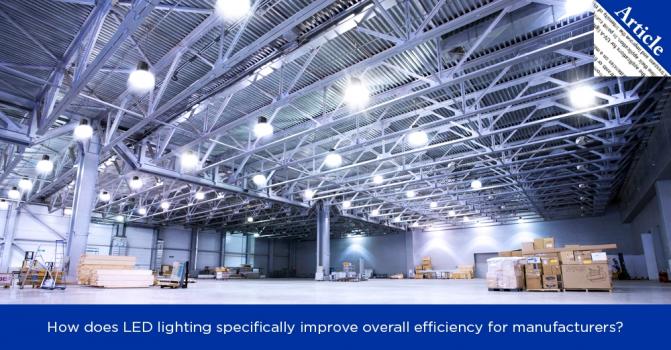How do LEDs Increase Efficiency?

Description
LEDs, or light-emitting diodes, are far more energy efficient than traditional incandescent, halogen, fluorescent, and high-intensity discharge light bulbs. They are sometimes referred to as ‘instant on’ lights because they don’t require time to warm up before they reach their full strength like incandescent and other bulbs do.
When lighting large areas, such as processing plants or manufacturing facilities, energy costs can be enormous. Changing the type of lighting used can shave off a lot of money from a company’s energy bill. For instance, LEDs consume less than 80% of the electricity of traditional incandescent bulbs! Imagine the cost savings of just making this one switch.
How LEDs Work
There are several reasons why LEDs are a much more cost-effective and energy-saving option for manufacturers than traditional incandescent bulbs, and it comes down to the way LEDs actually work and produce light.
First, LEDs pass electrons through a semiconductor that doesn’t have a filament, which means that the bulbs don’t get nearly as hot as incandescent bulbs, which emit light as a current is passed through the metal inside of them and heat up the metal.
Light from LEDs is produced in a variety of colors without giving off a lot of glare and can be turned on and off without depleting the bulb’s lifespan, unlike fluorescent or incandescent bulbs. This means that the lifespan of an LED is much longer compared to that of other traditional bulbs.
Advantages of LEDs
LEDs are more cost effective, energy saving, create a lighter footprint on the environment, are more durable and have a longer lifespan than the traditional standard filament, halogen and fluorescent bulbs.
The price of LEDs when they first came onto the market were expensive, but over the years they have gone down in price dramatically. Some LEDs have operating lifespans of 70,000 hours, which is a whopping ten times longer than traditional light bulbs!
So, while some LEDs may be more expensive than traditional bulbs, the cost savings is seen in the extended lifespan of the bulb.
LEDs do not contain filaments like regular light bulbs do, so they can withstand vibrations and external shocks much better, and can even be exposed to moist environments like outside in snow and rain without going dead. This makes them more durable and longer lasting.
LEDs can also be super compact in size and still pack quite a punch in terms of brightness and light intensity. This is great for manufacturing facilities that have small spaces that are hard to reach, but need to be well lit. Since the lifespan of LEDs is much longer, they won’t need to be changed as often, which can be difficult in hard-to-reach small spaces.
These energy-efficient lights also come in a variety of colors, which is great for emergency exit signs, signaling and warning signs, and other specialized lighting that is necessary in manufacturing or processing facilities.
While some manufacturers are sticking with traditional fluorescent and high-intensity discharge lighting, others are seeing the value of LEDs beyond their energy efficiency. The long lifespan of LEDs makes them almost maintenance-free, which can be just as valuable as the cost savings.
Example Cost and Environmental Savings
Financial cost effectiveness isn’t the only reason manufacturers should think about switching to a more energy efficient lighting system. The environment suffers greatly when big companies and manufacturers use resources that use a lot of energy, which can cause large amounts of carbon emissions that damage the ozone and environment. LEDs are a great way to light large industrial and commercial spaces while creating a much lighter footprint on the environment.
An energy company called E.ON was on a mission back in 2017 to replace much of the lighting in its buildings with LEDs in order to save 178 tonnes of carbon emissions each year, as well as pay for itself in savings over the course of only seven years.
When thinking of energy efficiency, a traditional 50-watt halogen bulb uses only 10pc of the electricity it actually consumes for producing light. However, LEDs are much more efficient. If commercial buildings that use halogen bulbs switched to LEDs, the energy bill would be reduced by 90pc.
The industrial and commercial sectors consume a lot of energy just in operating the facilities, so the environmental cost can be great. However, LEDs are eco-friendly as they don’t contain mercury or other dangerous and harmful gasses, and they do not emit harmful UV rays. This can be an issue with fluorescent bulbs when broken.
The large footprint that these sectors have on the environment should be concern enough to switch to more energy-efficient solutions. A 13-watt LED bulb emits 68pc less carbon dioxide than a standard 40-watt incandescent bulb while running 10 hours per day. Over time, large consumption of energy via lighting systems in these facilities can be done with a much lighter environmental footprint if LED lights are used instead of traditional lights.
